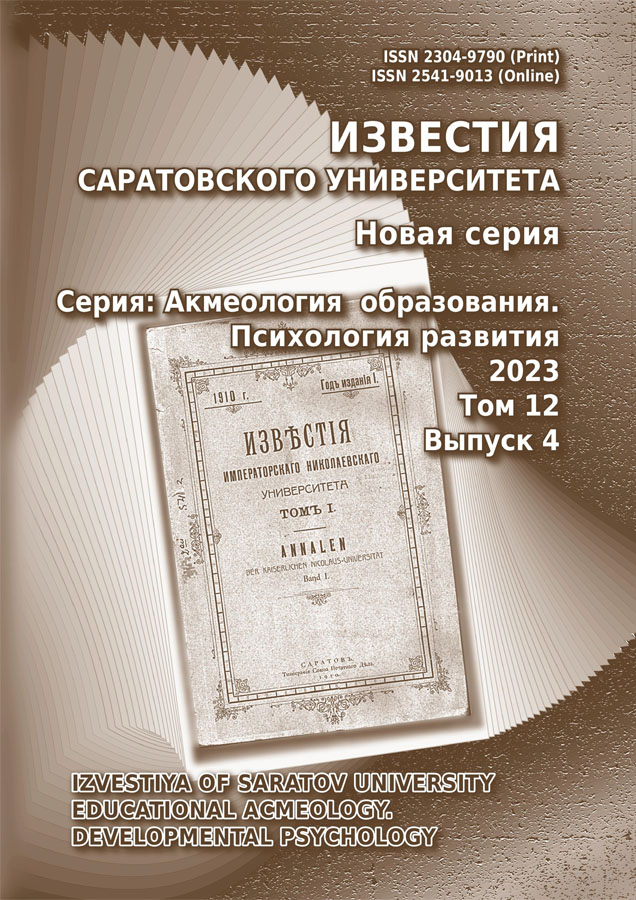Manifest and latent social groups: Phenomenon, evolution, determinants. Part 2
- Authors: Tolochek V.A.1
-
Affiliations:
- Institute of Psychology RAS
- Issue: Vol 12, No 2 (2023)
- Pages: 137-148
- Section: Articles
- URL: https://journal-vniispk.ru/2304-9790/article/view/251083
- DOI: https://doi.org/10.18500/2304-9790-2023-12-2-137-148
- EDN: https://elibrary.ru/SFLTLY
- ID: 251083
Cite item
Full Text
Abstract
Keywords
References
- Колесникова Е. И. Проявления коллективного субъекта учебной деятельности в студенческой группе // Вестник Самарской гуманитарной академии. Серия: Психология. 2011. № 1 (9). С. 113‒121.
- Сидоренков А. В. Психология малой группы: методология и теория. М. : Юрайт, 2018. 185 с.
- Шамионов Р. М., Бочарова Е. Е., Невский Е. В. Роль ценностей в приверженности молодежи различным видам социальной активности // Социальная психология и общество. 2022. Т. 13, № 1. C. 124‒141. https:// doi.org/10.17759/sps.2022130108
- Толочек В. А., Денисова В. Г., Журавлева Н. И. Динамика и условия профессионального становления субъекта в социономических профессиях // Психологический журнал. 2011. Т. 32, № 6. С. 41–48.
- Толочек В. А. Психология труда. СПб. : Питер, 2021. 496 с.
- Толочек В. А. Технологии профессионального отбора. М. : Юрайт, 2021. 253 с.
- Толочек В. А. Декларированные и латентные социальные группы: феномен, эволюция, детерминанты. Часть 1 // Известия Саратовского университета. Новая серия. Серия: Акмеология образования. Психология развития. 2022. Т. 11, вып. 3 (43). С. 220–231. https://doi.org/10.18500/2304-9790-2022-11-3-220-231
- Андреева Г. М. Социальная психология. М. : Изд-во Моск. ун-та, 1980. 416 с.
- Андреева Г. М. Социальная психология. М. : Аспект Пресс, 2005. 365 с.
- Парыгин Б. Д. Социальная психология. СПб. : СПбГУП, 2003. 616 с.
- Петровский А. В., Шпалинский В. В. Социальная психология коллектива. М. : Просвещение, 1978. 176 с.
- McClure B. A. Putting a New-Spin on Groups: The Science of Chaos. London : Lawrence Erlbaum, 1998. 248 р.
- Tajfel H. Intergroup Behavior, Social Comparison and Social Change. Unpublished Katz-Newcomb Lectures. Ann Arbor : University of Michigan, 1974. 24 p.
- Tajfel H., Turner J. An Integrative Theory of Intergroup Confl ict // The Social Psychology of Intergroup Relations / eds. W. Austin, S. Worchel. Monterey, CA : Brooks/Cole, 1979. P. 33‒47.
- Tajfel H., Turner J. The Social Identity Theory of Intergroup Behavior // Psychology of Intergroup Relations / eds. S. Worchel, W. Austin. 2nd ed. Chicago : Nelson-Hall, 1986. P. 7‒24.
- Turner J. Social Categorization and the Self-Concept: A Social Cognitive Theory of Group Behavior // Advances in Group Processes: Theory and Research / ed. E. J. Lawler. Greenwich, CT : JAI Press, 1985. Vol. 2. P. 77‒122.
- Turner J. Rediscovering the Social Group: A SelfCategorization Theory. Oxford : Basil Blackwell, 1987. 645 p.
- Сидоренков А. В. Неформальные подгруппы в малой группе: социально-психологический анализ. Ростов н/Д : АПСН СКНЦ ВШ, 2003. 436 с.
- Arrow H. Stability, bistability, and instability in small group infl uence patterns // Journal of Personality and Social Psychology. 1997. Vol. 72, no. 1. Р. 75‒85. https://doi.org/10.1037/0022-3514.72.1.75
- Arrow H., McGrath J. E., Berdahl J. L. Small Groups as Complex Systems: Formation, Coordination, Development, and Adaptation. Thousand Oaks, CA : Sage Publications Inc., 2000. 344 p. https://dx.doi.org/10.4135/9781452204666
- McGrath J. E., Tschan F. Temporal Matters in Social Psychology. Examining the Role of Time in the Lives of Groups and Individuals. Washington, DC : American Psychological Association, 2004. 179 p.
- Poole M. S., Seibold D. R., McPhee R. D. The Structuration of Group Decisions // Communication and Group Decision Making / eds. R. Y. Hirokawa, M. S. Poole. 2nd ed. Thousand Oaks, CA : Sage Publications Inc., 1996. P. 114‒146.
- Von Cranach M. Toward a theory of the acting group // Understanding Group Behavior: Small Group Processes and Interpersonal Relations / eds. E. Witte, J. H. Davis. Hillsdale, NJ : Lawrence Erlbaum, 1996. P. 147‒187.
- Сидоренков А. В., Сидоренкова И. И. Доверие в малых группах // Вопросы психологии. 2011. № 1. С. 94‒105.
- Cohen A. et al. Effective Behavior in Organizations. Homewood, Ill : Richard D. Irvin, Inc., 1980. 177 р.
- Tuckman B. W., Jensen M. A. Stages of small group development revisited // Group and Organizational Studies. 1977. Vol. 2, iss. 4. P. 419‒427. https://doi.org/10.1177/105960117700200404
- Парыгин Б. Д. Социальная психология как наука. Ленинград : Изд-во Ленингр. ун-та, 1965. 208 с.
- Tajfel H., Turner J. C. The Social Identity Theory of Intergroup Behavior. In: Jost J. T., Sidanius J., eds. Political Psychology: Key Readings. New York : Psychology Press, 2004. P. 276–293. https://doi.org/10.4324/9780203505984-16
- Turner J. C., Reynolds K. J. Self-Categorization Theory // Handbook of Theories of Social Psychology / eds. P. A. M. Van Lange, A. W. Kruglanski, E. T. Higgins. Los Angeles ; London : Sage Publications Ltd., 2012. P. 399–417. https://doi.org/10.4135/9781446249222.n46
- Знаков В. В. Психология возможного. М. : Изд-во «Институт психологии РАН», 2021. 308 с.
Supplementary files










